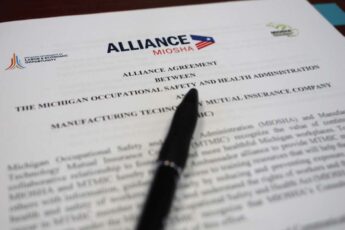By Ruth Kiefer, MSc, ARM
Vice President of Loss Control
To help you stay up to date on the most cited serious violations from MIOSHA, I attended CET’s annual release of the top 20 that they provide at their annual Michigan Safety Conference. You should be aware that both the number of citations and fines have increased 18 percent since 2023. In 2024, MIOSHA collected approximately $2.62 million in serious violations alone.
On the General Industry Safety violation side, approximately 546 citations were issued in 2024. They collected $1.9 Million in fines, which averages out to $3,400 for the average safety citation. Now for the Health side of things, as there are always two parts. The health side issued 547 citations and collected $659,700 in fines. The average citation per location was $1,200. If you are unsure if you have a Health or Safety violation, please contact your Loss Control Consultant for more guidance of these most cited violations listed below. We are happy to help you stay in compliance.
General Industry: Most Common Serious Safety Citations:
Part 85: The Control of Hazardous Energy 1910.147(c)(4)(i) Procedures shall be developed, documented and utilized for the control of potentially hazardous energy when employees are engaged in the activities covered by this section. Cited 36 times. Average citation: $28,000
Part 85: The Control of Hazardous Energy 1910.147(c)(7)(i)A. Each authorized employee shall receive training in the recognition of applicable hazardous energy sources, the type and magnitude of the energy available in the workplace, and the methods and means necessary for energy isolation and control. Cited 68 times. Average citation: $1,000
Part 85: The Control of Hazardous Energy 1910.147(c)(6)(i). The employer shall conduct a periodic inspection of the energy control procedure at least annually to ensure that the procedure and the requirements of this standard are being followed. Cited 52 times. Average citation: $2,200
Part 33: Personal Protective Equipment (PPE). Rule 408.13308 Personal Protective Equipment hazard assessment and equipment selection. (1) An employer shall assess the workplace to determine if hazards are present, or likely to be present, that necessitate the use of personal protective equipment. Cited 46 times. Average citation: $1,200
Part 1: General Provisions 408.10034(3). A point of operation guard or device shall be as prescribed in a specific standard, or, in the absence of a specific standard, shall be designed and constructed, when required, to prevent the machine operator exposed to the hazard from having any part of his or her body in the hazardous area of the operating cycle. A guard of device for the point of operation of nonproduction arbor press or straightening press is not required if the machine is equipped with a hand control that is designed to stop the ram action or return the ram to the up position when released. Cited 42 times. Average citation: $4,300
Part 85: The Control of Hazardous Energy 1910.147(c)(7)(i). The employer shall provide training to ensure that the purposes and function of the LOTO program are understood by employees and that the knowledge and skills required for the safe application, usage, and removal of the energy controls are acquired by employees. The training shall include the following for Authorized, Affected, and Other. Cited 41 times. Average citation: $3,000
Part 7: Guards for Power Transmission. Rule 408.10727(1) Belts. (1) A belt and pulley that is 7 feet or less above the floor or platform and that is exposed to contact must be guarded. Cited 37 times. Average citation: $1,800.
Part 2: Walking Working Surfaces. Rule 1910.28(b)(1)(I). Unprotected sides and edges. The employer must ensure that each employee on a walking-working surface with an unprotected side or edge that is 4 feet or more above a lower level is protected from falling by one or more of the following: (A) guard rail system, (B) Safety net system or (C) Personal fall protection systems, such as personal fall arrest, travel restraint, or positioning systems. Cited 37 times. Average citation: $3,600
Part 1: General Provisions. Rule 408.10034(9) Pinch Points. When an employee is exposed to a hazard created by a pinch point other than point of operation, the hazard shall be guarded, or the employee otherwise protected. Cited 33 times Average citation: $3,300 This includes your overhead doors. All powered overhead and sliding doors must be equipped with either a sensing strip, photoelectric eye, constant pressure down control switch or a slip clutch device.
Part 7: Guards for Power Transmission. Rule 408.10727(1) Gears, Sprockets, and Chain drives. Gears, sprockets, and chain drives exposed to contact shall be guarded. This does not apply to hand-operated gear sprockets and chain drives used to adjust machine parts which do not move after the hand power is removed. Cited 35 times Average citation: $2,800.
General Industry: Most Cited Serious Health Violations
Part 92: Hazard Communication. 1910.1200(e)(1). Employers shall develop, implement, and maintain at each workplace, a written hazard communication program which at least describes how the criteria specified in paragraphs (f), (g), and (h) of this section for labels and other forms of warning, safety data sheets, and employee information and training will be met. Cited 126 times Average citation: $1,200
Part 472: Medical Services and First Aid. 325.47201(3). Eyewash and Quick Drenching Requirement. An employer shall ensure that suitable facilities for quick drenching or flushing of eyes and body are provided within the work area for immediate emergency use when the eyes or body of any person may be exposed to injurious corrosive materials. Cited 107 times Average citation: $1,200
Part 92: Hazard Communication. Information and Training Requirement. 1910.1200(h)(3). Employers must train on the new Global Harmonization System of Classification and labeling of chemicals. They must be able to read the new SDS’s. Cited 76 times Average citation: $1,300.
Part 451: Respiratory Protection. 1910.134(c)(1). A written Program is required as part of this standard. Cited 49 times Average citation. $200
Part 451: Respiratory Protection. Voluntary Respirator Protection 1910.134(c)(2). An employer may provide respirators at the request of the employees or permit employees to use their own respirators, if the employer determine that the respirator will not in itself create a hazard. Provide information in Appendix D to all comfort respirator users. Employer must have a written program to ensure that any employee using a respirator voluntarily is medically able, and properly cleans, stores and maintains is so it does not present a health hazard to the user. Cited 46 times Average citation. $1,400 Exemption: Employers are NOT required to include a written respiratory protection program for those employees whose use of respirators involves the voluntary use of filtering facepieces (dust masks).
Part 451: Respiratory Protection. Medical Evaluations 1910.134(e)(1). The employer shall provide a medical evaluation to determine the employee’s ability to use a respirator, before the employee is fit tested or required to use the respirator in the workplace. The employer may discontinue an employee’s medical evaluation when the employee is no longer required to use the respirator. Cited 28 Average citation: $500
Part 1: General Provisions. Rule 408.10011 General Duties of an Employer. An employer shall (a) furnish to each employee employment and a place of employment that is free from recognized hazards that are causing, or likely to cause, death or serious physical harm to the employee. Cited 23 times Average citation: $5,100
Part 90: Permit-Required Confined Spaces. 1910.146(c)(2). General Requirements. If the workplace contains permit spaces, the employer shall inform exposed employees, by posting danger signs or by any other equally effective means, of the existence and location of and the danger posed by the permit spaces. Sign must read: DANGER- PERMIT-REQUIRED CONFINED SPACE, DO NOT ENTER Cited 22 times Average citation: $700
Part 33: Personal Protective Equipment (PPE). Eye & Face Protection. Rule 408.13311(1). All protective eye and face protection devices shall comply with any of the following consensus standards: ANSI/ISEA Z-87.1, ANSI Z-87.1, ANSI Z87.1 Cited 21 times Average citation: 1,200
Part 451: Respiratory Protection. 1910.134(f)(2). Fit Testing. You must fit test respirators prior to their use for all tight fitting or required respirators, whenever a different respirator face-piece is used, or at least annually. Cited 22 times Average citation: $0 Prior years citation was $500
Parts 42, 92, and 430: – Hazard Communication and Right-to-know Requirements. 408.1014(j) Signs throughout workplace. An employer shall post signs throughout the workplace advising employees of all of the following: 1) location of the safety data sheets, 2) Employer is prohibited from discharging or discriminating against an employee, 3) MIOSHA’s telephone number. Cited 20 times Average Citation: 0
For questions on the above information, please contact your loss control representative.






